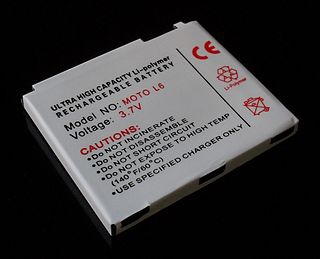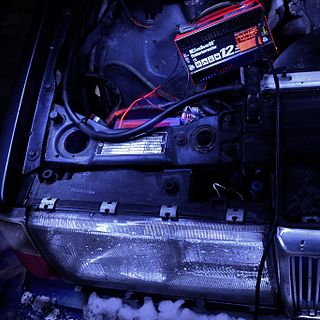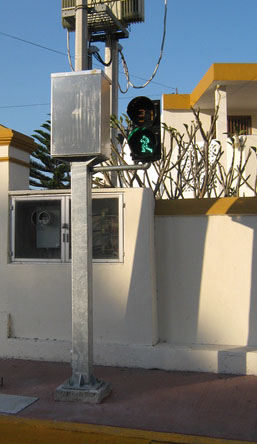Related Research Articles

A nickel–metal hydride battery is a type of rechargeable battery. The chemical reaction at the positive electrode is similar to that of the nickel-cadmium cell (NiCd), with both using nickel oxide hydroxide (NiOOH). However, the negative electrodes use a hydrogen-absorbing alloy instead of cadmium. NiMH batteries can have two to three times the capacity of NiCd batteries of the same size, with significantly higher energy density, although only about half that of lithium-ion batteries.

The nickel–cadmium battery is a type of rechargeable battery using nickel oxide hydroxide and metallic cadmium as electrodes. The abbreviation Ni–Cd is derived from the chemical symbols of nickel (Ni) and cadmium (Cd): the abbreviation NiCad is a registered trademark of SAFT Corporation, although this brand name is commonly used to describe all Ni–Cd batteries.

A lithium-ion or Li-ion battery is a type of rechargeable battery that uses the reversible intercalation of Li+ ions into electronically conducting solids to store energy. In comparison with other rechargeable batteries, Li-ion batteries are characterized by higher specific energy, higher energy density, higher energy efficiency, a longer cycle life, and a longer calendar life. Also noteworthy is a dramatic improvement in lithium-ion battery properties after their market introduction in 1991: within the next 30 years, their volumetric energy density increased threefold while their cost dropped tenfold.

A rechargeable battery, storage battery, or secondary cell, is a type of electrical battery which can be charged, discharged into a load, and recharged many times, as opposed to a disposable or primary battery, which is supplied fully charged and discarded after use. It is composed of one or more electrochemical cells. The term "accumulator" is used as it accumulates and stores energy through a reversible electrochemical reaction. Rechargeable batteries are produced in many different shapes and sizes, ranging from button cells to megawatt systems connected to stabilize an electrical distribution network. Several different combinations of electrode materials and electrolytes are used, including lead–acid, zinc–air, nickel–cadmium (NiCd), nickel–metal hydride (NiMH), lithium-ion (Li-ion), lithium iron phosphate (LiFePO4), and lithium-ion polymer.

A lithium polymer battery, or more correctly lithium-ion polymer battery, is a rechargeable battery of lithium-ion technology using a polymer electrolyte instead of a liquid electrolyte. Highly conductive semisolid (gel) polymers form this electrolyte. These batteries provide higher specific energy than other lithium battery types and are used in applications where weight is a critical feature, such as mobile devices, radio-controlled aircraft and some electric vehicles.
Memory effect, also known as battery effect, lazy battery effect, or battery memory, is an effect observed in nickel-cadmium rechargeable batteries that causes them to hold less charge. It describes the situation in which nickel-cadmium batteries gradually lose their maximum energy capacity if they are repeatedly recharged after being only partially discharged. The battery appears to "remember" the smaller capacity.

The AA battery is a standard size single cell cylindrical dry battery. The IEC 60086 system calls the size R6, and ANSI C18 calls it 15. It is named UM-3 by JIS of Japan. Historically, it is known as D14, U12 – later U7, or HP7 in official documentation in the United Kingdom, or a pen cell.

A battery charger, recharger, or simply charger, is a device that stores energy in a battery by running an electric current through it. The charging protocol depends on the size and type of the battery being charged. Some battery types have high tolerance for overcharging and can be recharged by connection to a constant voltage source or a constant current source, depending on battery type. Simple chargers of this type must be manually disconnected at the end of the charge cycle. Other battery types use a timer to cut off when charging should be complete. Other battery types cannot withstand over-charging, becoming damaged, over heating or even exploding. The charger may have temperature or voltage sensing circuits and a microprocessor controller to safely adjust the charging current and voltage, determine the state of charge, and cut off at the end of charge. Chargers may elevate the output voltage proportionally with current to compensate for impedance in the wires.

The lithium iron phosphate battery or LFP battery is a type of lithium-ion battery using lithium iron phosphate as the cathode material, and a graphitic carbon electrode with a metallic backing as the anode. Because of their lower cost, high safety, low toxicity, long cycle life and other factors, LFP batteries are finding a number of roles in vehicle use, utility-scale stationary applications, and backup power. LFP batteries are cobalt-free. As of September 2022, LFP type battery market share for EVs reached 31%, and of that, 68% was from Tesla and Chinese EV maker BYD production alone. Chinese manufacturers currently hold a near monopoly of LFP battery type production. With patents having started to expire in 2022 and the increased demand for cheaper EV batteries, LFP type production is expected to rise further and surpass lithium nickel manganese cobalt oxides (NMC) type batteries in 2028.

A deep-cycle battery is a battery designed to be regularly deeply discharged using most of its capacity. The term is traditionally mainly used for lead–acid batteries in the same form factor as automotive batteries; and contrasted with starter or 'cranking' automotive batteries designed to deliver only a small part of their capacity in a short, high-current burst for cranking the engine.

An electric vehicle battery is a rechargeable battery used to power the electric motors of a battery electric vehicle (BEV) or hybrid electric vehicle (HEV).
In electronics, the cut-off voltage is the voltage at which a battery is considered fully discharged, beyond which further discharge could cause harm. Some electronic devices, such as cell phones, will automatically shut down when the cut-off voltage has been reached.
Depth of discharge (DoD) is an important parameter appearing in the context of rechargeable battery operation. Two non-identical definitions can be found in commercial and scientific sources. The depth of discharge is defined as:
- the maximum fraction or percentage of a battery's capacity which is removed from the charged battery on a regular basis. "Charged" does not necessarily refer to fully or 100 % charged, but rather to the state of charge (SoC), where the battery charger stops charging, which is achieved by different techniques.
- the fraction or percentage of the battery's capacity which is currently removed from the battery with regard to its (fully) charged state. For fully charged batteries, the depth of discharge is connected to the state of charge by the simple formula . The depth of discharge then is the complement of state of charge: as one increases, the other decreases. This definition is mostly found in scientific sources.

The lithium–sulfur battery is a type of rechargeable battery. It is notable for its high specific energy. The low atomic weight of lithium and moderate atomic weight of sulfur means that Li–S batteries are relatively light. They were used on the longest and highest-altitude unmanned solar-powered aeroplane flight by Zephyr 6 in August 2008.

A battery is a source of electric power consisting of one or more electrochemical cells with external connections for powering electrical devices. When a battery is supplying power, its positive terminal is the cathode and its negative terminal is the anode. The terminal marked negative is the source of electrons that will flow through an external electric circuit to the positive terminal. When a battery is connected to an external electric load, a redox reaction converts high-energy reactants to lower-energy products, and the free-energy difference is delivered to the external circuit as electrical energy. Historically the term "battery" specifically referred to a device composed of multiple cells; however, the usage has evolved to include devices composed of a single cell.
The lithium–air battery (Li–air) is a metal–air electrochemical cell or battery chemistry that uses oxidation of lithium at the anode and reduction of oxygen at the cathode to induce a current flow.
Aluminium-ion batteries are a class of rechargeable battery in which aluminium ions serve as charge carriers. Aluminium can exchange three electrons per ion. This means that insertion of one Al3+ is equivalent to three Li+ ions. Thus, since the ionic radii of Al3+ (0.54 Å) and Li+ (0.76 Å) are similar, significantly higher numbers of electrons and Al3+ ions can be accepted by cathodes with little damage. Al has 50 times (23.5 megawatt-hours m-3) the energy density of Li and is even higher than coal.
This is a list of commercially-available battery types summarizing some of their characteristics for ready comparison.
Capacity loss or capacity fading is a phenomenon observed in rechargeable battery usage where the amount of charge a battery can deliver at the rated voltage decreases with use.
Research in lithium-ion batteries has produced many proposed refinements of lithium-ion batteries. Areas of research interest have focused on improving energy density, safety, rate capability, cycle durability, flexibility, and cost.
References
- ↑ Preger, Yuliya; Barkholtz, Heather M.; Fresquez, Armando; Campbell, Daniel L.; Juba, Benjamin W.; Romàn-Kustas, Jessica; Ferreira, Summer R.; Chalamala, Babu (1 August 2022). "Degradation of Commercial Lithium-Ion Cells as a Function of Chemistry and Cycling Conditions". Journal of the Electrochemical Society. 167 (12): 120532. doi: 10.1149/1945-7111/abae37 . S2CID 225506214.
- ↑ "Understanding the Trilemma of Fast Charging, Energy Density and Cycle Life of Lithium-ion Batteries". 1 August 2022.
- ↑ "Powerstation im Test" (in German). 1 August 2022.
- ↑ Tony Bove (2 February 2010). iPod & iTunes For Dummies, Book + DVD Bundle. John Wiley & Sons. p. 26. ISBN 978-0-470-59070-6 . Retrieved 19 June 2013.
- ↑ G. S. George (1 January 2007). Applied Science II. Technical Publications. p. 8. ISBN 978-81-8431-146-4.
- ↑ United Nations (2009). Recommendations on the Transport of Dangerous Goods: Manual of Tests and Criteria. United Nations Publications. p. 394. ISBN 978-92-1-139135-0.
- ↑ Davide Andrea (2010). Battery Management Systems for Large Lithium Ion Battery Packs. Artech House. p. 189. ISBN 978-1-60807-105-0 . Retrieved 19 June 2013.
- ↑ Batteries - Why Lithium-ion? - Apple